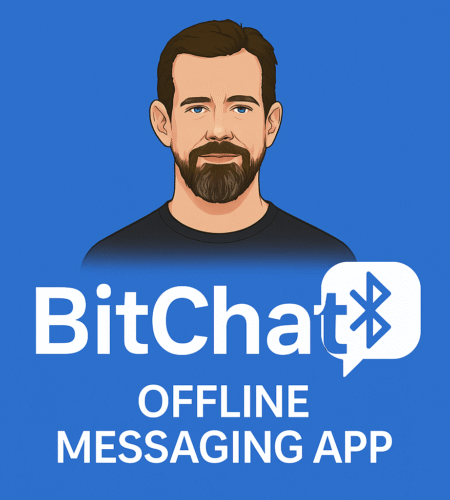In a world increasingly dependent on centralized infrastructure, one app is daring to ask: What if we didn’t need the internet at all to communicate? Enter Bit Chat, a revolutionary new messaging platform from Twitter founder Jack Dorsey. Unlike traditional chat apps that rely on Wi-Fi, mobile data, or even satellites, Bit Chat operates entirely offline, leveraging Bluetooth Low Energy (BLE) and mesh networking to enable direct, encrypted communication between phones.
Let’s explore how it works, why it matters, and what it could mean for the future of communication.
How Bit Chat Works: The Tech Behind the Magic
Bit Chat runs on a beautifully simple yet technically brilliant concept: use Bluetooth to turn every phone into both a sender and a relay for messages, creating a decentralized, peer-to-peer communication network. Here’s a breakdown of how it achieves that:
1. Bluetooth Low Energy (BLE) & B Advertisements
Bit Chat uses BLE, a power-efficient variant of Bluetooth that’s optimized for short-range, low-bandwidth communication. BLE devices periodically send out advertisements—tiny data packets limited to just 31 bytes.
That may not sound like much, but Bit Chat works around this limitation with clever engineering.
2. Message Chunking with LZ4 Compression
Messages are compressed using LZ4, a high-speed, lossless compression algorithm. This allows larger messages to be split into tiny data chunks, each small enough to fit within the 31-byte BLE advertisement size.
These chunks are then broadcast via Bluetooth, hopping between devices as needed.
3. Mesh Networking: Phones as Nodes
If the recipient is nearby (within ~30 meters), they’ll receive the message chunks directly and reassemble them.
But if the recipient is out of range—say, 100 meters away—Bit Chat employs a BLE mesh network. Other Bit Chat-enabled phones in the vicinity act as relay nodes, picking up the message and forwarding it via their own Bluetooth. The message “hops” from phone to phone until it reaches its target.
4. End-to-End Encryption & RAM-Only Storage
Privacy is at the heart of Bit Chat’s design. Messages are end-to-end encrypted, meaning only the sender and receiver can read them. No third-party servers. No metadata leaks.
Additionally, Bit Chat stores message data only in RAM, not on disk. This ephemeral storage is paired with a TTL (Time-To-Live) mechanism, so message chunks automatically expire after a short period. This ensures both privacy and resource efficiency.
Why Bit Chat Matters
Bit Chat is more than a quirky tech experiment—it’s a bold reimagining of how we communicate in a digitally monopolized world.
1. Disaster Resilience
When hurricanes, earthquakes, or other disasters knock out infrastructure, Bit Chat could enable lifesaving communication without cell towers, satellites, or internet access.
2. Censorship Resistance
Bit Chat’s decentralized nature makes it nearly impossible to censor or shut down. Governments can block websites and cellular access, but they can’t block Bluetooth signals hopping between phones.
3. Privacy by Design
With no central servers and full end-to-end encryption, Bit Chat avoids the surveillance capitalism model that plagues most messaging platforms.
4. Digital Equity
In regions where internet access is expensive or unreliable, Bit Chat could provide a zero-cost alternative for basic communication, assuming there’s enough local device density.
Limitations & Challenges
As promising as Bit Chat is, it’s not without its trade-offs:
- Limited Range: BLE maxes out at around 30 meters. Longer-distance messaging depends on other users forming a dense enough mesh.
- Battery Drain: BLE is efficient, but frequent scanning and broadcasting can still impact battery life.
- Latency: Messages may take time to reach recipients, especially in sparse networks.
- Adoption: The system’s utility increases exponentially with the number of users. Without widespread use, it won’t be very effective.
Explore the Code: Bit Chat on GitHub
Curious to see how it all works under the hood? The Bit Chat project is open-source, and you can explore the code, contribute, or even fork your own version of it.
Official GitHub Repository: https://github.com/permissionlesstech/bitchat
Whether you’re a developer, researcher, or privacy advocate, this repo is a goldmine of innovation around peer-to-peer mesh communication.
The Future of Peer-to-Peer Communication
Bit Chat is a glimpse into what a truly decentralized communication ecosystem could look like. If it gains traction, it could:
- Offer resilient communication during blackouts or internet shutdowns
- Serve activist communities where censorship is a concern
- Help in rural areas with no reliable internet or cell coverage
- Encourage developers to build mesh-native apps for file sharing, alerts, and more
In a sense, Bit Chat turns every phone into a tiny infrastructure node, empowering people to build their own networks rather than rent access from telecom giants.
Conclusion: A New Paradigm for Digital Communication
Jack Dorsey’s Bit Chat isn’t just another messaging app—it’s a philosophical shift. It asks, What if we took control of our communication back from the cloud? What if our phones, collectively, could become the network?
Of course, Bit Chat still has technical and adoption hurdles to overcome. But its core idea is both timely and powerful—particularly in a world where central points of failure (and control) are becoming more dangerous.
If the 2010s were about building walled gardens of social media, maybe the 2020s will be about building open forests—messy, resilient, peer-powered systems like Bit Chat.
Want to Try Bit Chat?
While the app is still evolving, you can follow the project, contribute, or experiment by visiting the GitHub page:
https://github.com/permissionlesstech/bitchat
Decentralized communication might just be the next big leap in human connection.


Comments